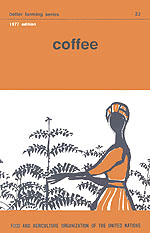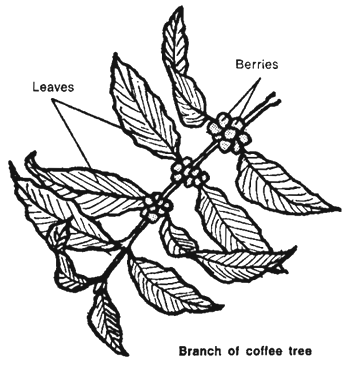
| better farming series | 23 |
| FAO Economic and Social Development Series | No. 3/23 |
 | Coffee |
Published by arrangement with the
Institut africain pour le développement économique et social
B.P. 8008, Abidjan, Côte d'Ivoire
First printing 1970
Second printing 1977
P-69
ISBN 92-5-100624-5
BETTER FARMING SERIES
Twenty-six titles have been published in this series, designed as handbooks for a two-year intermediate level agricultural education and training course. They may be purchased as a set or as individual documents.
FIRST YEAR
SECOND YEAR
This manual is a translation and adaptation of “Le caféier,” published by the Agri-Service-Afrique of the Institut africain pour le développement économique et social (INADES), and forms part of a series of 26 booklets. Grateful acknowledgement is made to the publishers for making available this text, which it is hoped will find widespread use at the intermediate level of agricultural education and training in English-speaking countries.
It should be noted that the original texts were originally prepared for an African environment and this is naturally reflected in the English version. However, it is expected that many of the manuals of the series — a list of which will be found on the inside front cover — will also be of value for training in many other parts of the world. Adaptations can be made to the text where necessary owing to different climatic and ecological conditions.
Applications for permission to issue this manual in other languages are welcomed. Such applications should be addressed to: Director, Publications Division, Food and Agriculture Organization of the United Nations, Via delle Terme di Caracalla, 00100, Rome, Italy.
The cover illustrations were prepared by Asun Balzola.
Coffee tree

FOOD AND AGRICULTURE ORGANIZATION OF THE UNITED NATIONS
Rome 1977
© French edition, Institut africain pour
le développement économique et social (INADES) 1967
© English edition, FAO 1970
Hyperlinks to non-FAO Internet sites do not imply any official endorsement of or responsibility for the opinions, ideas, data or products presented at these locations, or guarantee the validity of the information provided. The sole purpose of links to non-FAO sites is to indicate further information available on related topics.
This electronic document has been scanned using optical character recognition (OCR) software. FAO declines all responsibility for any discrepancies that may exist between the present document and its original printed version.
What varieties of coffee are grown in Africa?
• Choosing the seeds or seedlings
Lifting the young seedlings from the seed beds
Transplanting the seedlings into a nursery.
• Choosing a site and preparing the plantation
Tracing rows and digging holes for planting
Sheltering the young coffee trees
Planting coffee trees in the plantation
• Taking care of the plantation
Upkeep of the soil cover and hoeing
Protecting trees from insects and diseases
The coffee tree bears fruit which are called berries.

The berries contain two seeds called coffee beans.
